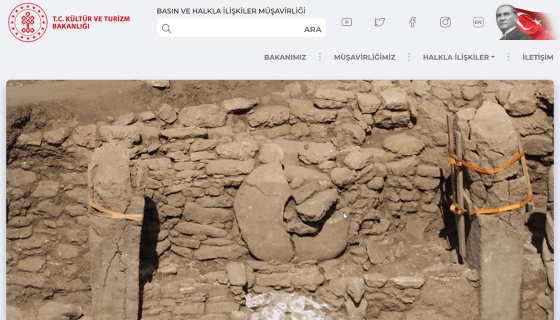A ``huge statue of a human holding a penis'' from about 11,000 years ago is discovered at an ancient ruin in Turkey

During an excavation survey conducted in September 2023 at the Neolithic
TARİHİN SIFIR NOKTASINDA İLK BOYALI HEYKEL BULUNDU
https://basin.ktb.gov.tr/TR-350158/tarihin-sifir-noktasinda-ilk-boyali-heykel-bulundu.html

New Statues and Fresh Insights from Karahan Tepe and Göbekli Tepe | Ancient Origins
https://www.ancient-origins.net/news-history-archaeology/karahan-tepe-0019457
Sculpture Of Man Holding Penis Discovered Near A Temple In Turkey | Pics | Viral News, Times Now
https://www.timesnownews.com/viral/penis-sculpture-of-man-turkey-article-104164728
11,000-year-old statue of giant man clutching penis unearthed in Turkey | Live Science
https://www.livescience.com/archaeology/11000-year-old-statue-of-giant-man-clutching-penis-unearthed-in-turkey
Excavations carried out at the Karakhan Tepe ruins in September uncovered a 2.3 meter tall statue of a man. This statue was unique in that its ribs and shoulder bones were prominent, indicating that it may have been made to represent a 'dead person,' but what's even more surprising is that it has its own penis. I was holding it.
The photo below is an actual excavated statue of a man holding a penis, and it certainly looks like he is holding a penis with both hands. When the statue was discovered, it was broken in two and the upper part was said to have been lying on a bench, but it is believed that it was originally in an upright position as shown in the photo.

This is what it looks like from the side. The statue at the Karakhan Tepe ruins is believed to be about 11,000 years old, and may be the ``oldest naturalistic life-sized human statue.''

It has also been reported that the following ``statue imitating a vulture'' was also discovered near the Karakhan Tepe ruins.

At the same time, excavations at the Göbekli Tepe ruins also unearthed a life-sized statue of a boar made of limestone, measuring 1.35 meters in length and 0.7 meters in height. This statue dates back about 10,700 to 10,200 years ago, and it is said that red, black, and white pigments remained on the surface.

Benjamin Arbuckle , a professor of anthropology at the University of North Carolina at Chapel Hill who was not involved in the excavation, said, ``The latest and most spectacular discoveries from these sites are the first to reveal our understanding of pre-agricultural societies.'' 'We are changing our understanding of the world in a big way.' Pre-agricultural hunter-gatherer societies have been thought to have been relatively small-scale and egalitarian, but sophisticated carvings found at sites such as Karakhan Tepe suggest a more complex organization. It is said to suggest the existence of society.
Edward Banning , a professor of anthropology at the University of Toronto who was also not involved in the excavations, points out that although this is just speculation, there is a high possibility that the statues found at Karakhan Tepe are of deceased people. . 'The fact that the statue is clutching a penis may symbolize that this person is the founder of a social group, such as a family or clan, associated with the building.'
Related Posts:
in Science, Posted by log1h_ik







